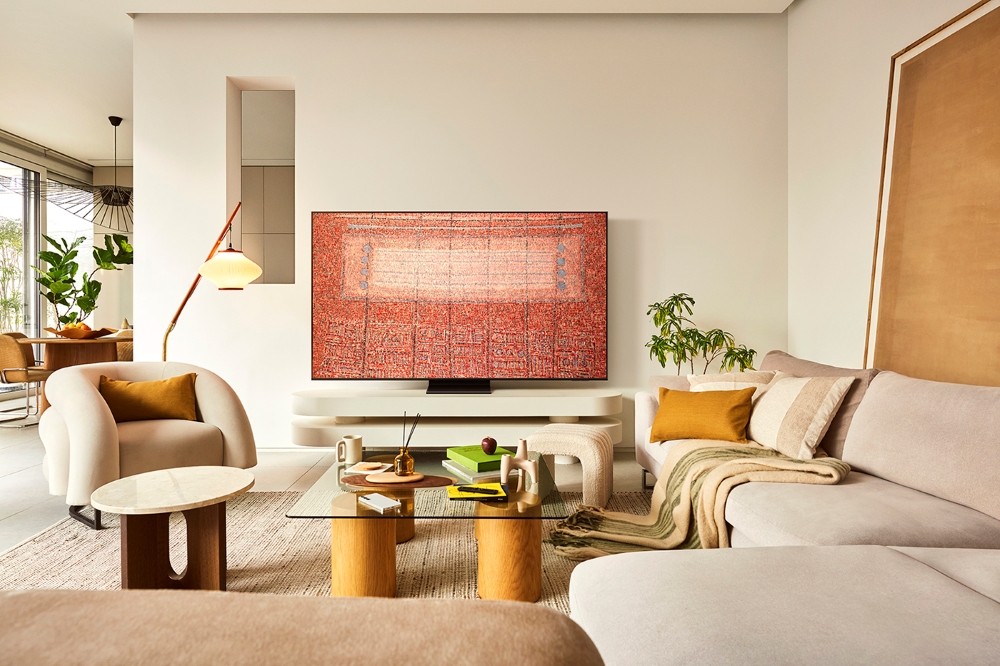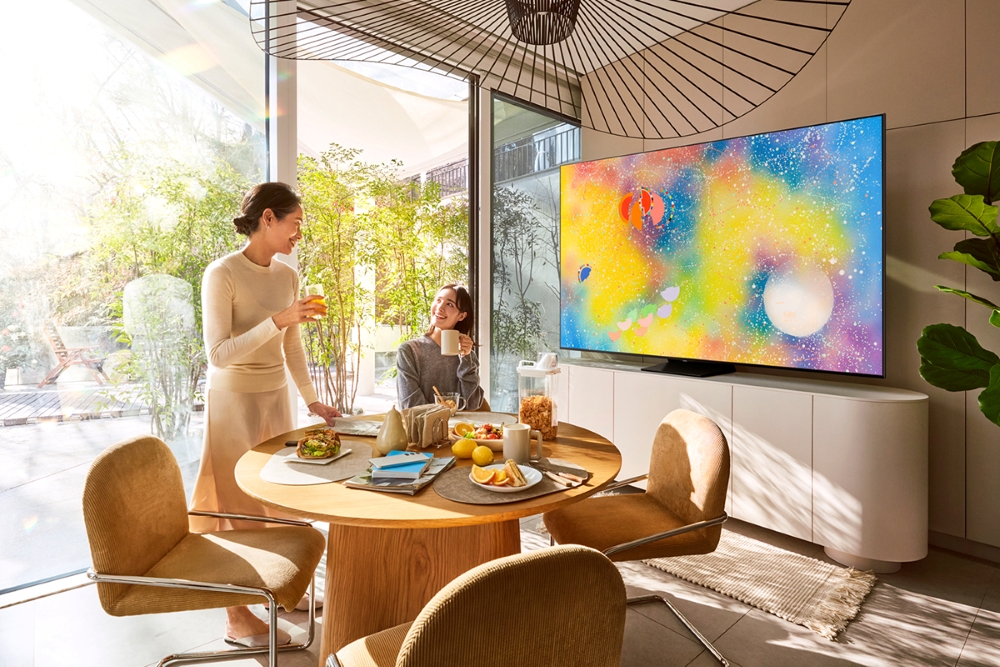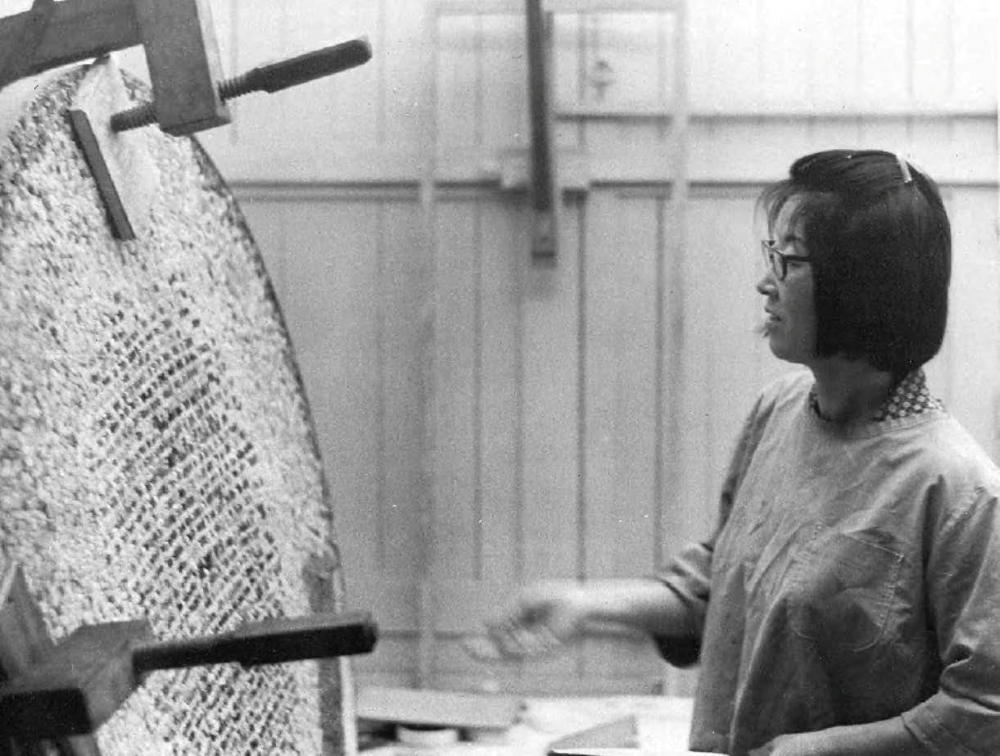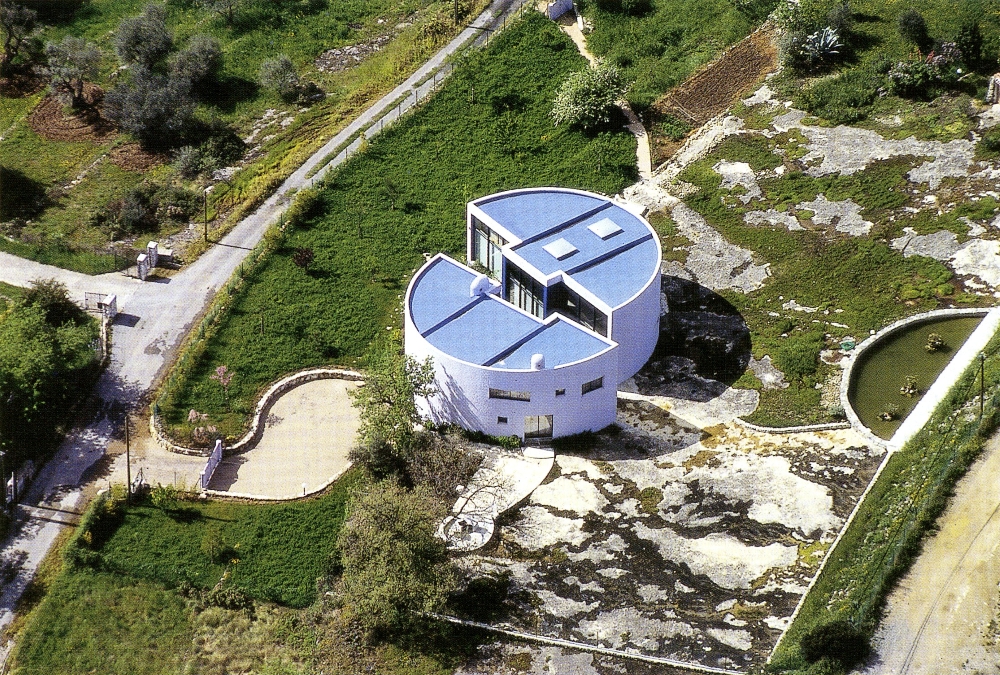In recent years, Korean culture has become one of the most dynamic forces in the global creative scene. From music and film to fashion and art, its influence now extends far beyond national borders, drawing new attention to the ideas and aesthetics that have shaped the region for centuries. Long before this renaissance, however, one painter was already building a bridge between Korea and the West, bringing a distinct Korean sense of rhythm and balance into the language of modern abstraction.
Seundja Rhee (1918-2009) forged a singular abstract language between Seoul and Paris, translating the cycles of nature, cityscapes and cosmic symbolism into color and form. Long recognized by curators and historians for expanding the possibilities of post-war abstract art, Rhee is one of the earliest Korean women artists to gain international recognition in the genre. A newly curated selection of her works is now available on Samsung Art Store, offering a close-up experience of her art without the limitations of time and place.
![[Interview] Notes on Seundja Rhee: Translating Nature’s Rhythms Into a Language of Light and Form [Interview] Notes on Seundja Rhee: Translating Nature’s Rhythms Into a Language of Light and Form](https://img.global.news.samsung.com/global/wp-content/uploads/2025/11/14172200/Samsung-TVs-and-Displays-Samsung-Art-Store-Seundja-Rhee-Interview_main1-1.jpg)
Reintroducing a Modern Master of Abstract
The launch of Rhee’s collection goes beyond a digital exhibition; it represents a unique collaboration between the extensive archives of Gallery Hyundai, which has dedicated years to documenting and researching her work, and Samsung’s innovative technology that brings new clarity into every layer of art. This partnership invites global audiences to rediscover a modern pioneer of abstract painting.
Samsung Newsroom spoke with Young-Sook Kwon, director of Gallery Hyundai, about Seundja Rhee’s artistic legacy and the significance of bringing her work into the digital age.
Seundja Rhee developed a distinctive visual language while spending time between France and Korea, earning international recognition in an era when few women artists achieved such visibility. Her works explore themes of nature, the universe and human existence, carrying a powerful resonance that still feels vivid today.
A Pioneer Who Pushed the Boundaries of Korean Abstract Art
Q. How is Rhee recognized in Korean abstract art history?
She is regarded as the first woman abstract artist in Korea, one who independently expanded the language of abstraction through continuous stylistic development. While in Paris, Rhee went studied abstract painting and sculpture at the Académie de la Grande Chaumière, an institution known for shaping artists such as Pablo Picasso and Paul Gauguin. This experience deepened her appreciation for contemporary abstract art. In 1956, she debuted at the National Society of Fine Arts exhibition, where critic George Boudaille praised her work, marking her entry into the European art scene.
Over her remarkable six-decade career, she endured both the hardships of a turbulent modern era and the personal constraints of a patriarchal and traditional society, overcoming that pain through art.
Her style remains distinctive even within contemporary abstract art, portraying art as a creative energy that heals wounds and reflects on human existence, rather than the expressionists, who conveyed the unrestrained expression of their inner selves. Throughout her life, she imbued her work with a worldview that continually evolved and expanded.

Q. What is the key theme or aesthetic characteristic that runs through her work?
Her art reflects the pursuit of harmony with all things in the universe, a balance achieved through unity with nature and a long-standing virtue in Korean spiritual culture. Her ability to express this Eastern philosophy within the framework of Western abstract painting marks a significant contribution to both Korean and global art history.
A phrase that aptly encapsulates her artistic vision could be: “Yin, Yang, and the Milky Way Flowing Between Them,” as proposed by art critic Eun-rok Shim in the book commemorating the 100th anniversary of Rhee’s birth. A phrase that, in my view, beautifully articulates her worldview.
Samsung Art Store: A Digital Platform That Brings the Artist’s Touch and Spirit to Life
Q. What significance does the extensive archive of Gallery Hyundai, which has worked closely with Rhee for nearly 70 years, hold in Korean art history, and how does it facilitate a re-examination of her artistic legacy?
Our extensive archives provide a rich foundation for research from multiple perspectives. Seundja Rhee stands alongside Whanki Kim and Youngkuk Yoo as a pioneer of Korean abstract art, having boldly moved to Paris despite the hardships posed by the Korean War and gaining significant recognition there as a woman artist. In 1974, Gallery Hyundai’s founder, Myung-ja Park, hosted Rhee’s solo exhibition devoted entirely to her abstract works. It marked the beginning of the gallery’s longstanding support of Korea’s first woman abstract painter, who later became the gallery’s exclusive artist.
Rhee’s story, one that charts a new abstract language distinct from the trajectory of Western modernism, continues to inspire artists of all generations who are shaped by different cultures. After a 20th century largely dominated by male narratives in contemporary art, our journey with Rhee stands as a significant milestone in art history, particularly at a moment when there is a renewed interest in revisiting the contributions of women artists.
In 2018, Gallery Hyundai commemorated the 100th anniversary of Seundja Rhee’s birth with a major exhibition at the National Museum of Modern and Contemporary Art, drawing on its extensive artist archives. Building on this legacy, we are now preparing a new exhibition that will feature many materials not yet released to the public.
Q. What motivated this collaboration with Samsung Art Store? What do you hope to achieve from making Rhee’s works accessible to the public?
I believe that Samsung Art Store, as a digital platform that transcends physical boundaries, can introduce her work to audiences in many countries who might not have had the opportunity to experience it in person. I hope this collaboration allows more generations to discover the joy of engaging with her art.

Q. How does the Art Store enhance the experience of Rhee’s work?
Her paintings are known for their delicate, intricate layers that overlap the canvas. Her woodblock prints reveal her signature carving techniques — short, thick lines that taper to a fine point. On a digital screen, viewers can observe her unique touch more closely and take their time appreciating the spirit she infuses into each piece. This is the aspect of the collaboration I find most exciting.
Q. How did you curate the collection for the Art Store?
We selected representative pieces from different periods of her career, along with works of significant importance. The collection spans from her 1959 piece, marking a transition towards abstract art, to the “Cosmos” series created during her final years, tracing the evolution of her worldview throughout her life.
Q. What are your top three works from Rhee available through the Art Store?
1. No. 1 “The Snow from Vaugirard Street” – completed five years after she began her journey in the art world.
2. No. 7 “A Mother I Remember” – a defining work from the 1960s.
3. No. 19 “A City of September” – her final painting.
Q. Do you have a message for the public encountering her work for the first time through this launch?
Life is never without challenges, and Rhee’s was no exception. Born in 1918 during the Japanese colonial period, she endured both personal loss and the upheavals of modern history. Yet, she maintained extraordinary courage and strength, using art to express essential themes such as communication, coexistence, and the joy of life. Through Samsung Art Store, I hope audiences will find a deep appreciation for the vibrancy of life that fills her canvases.

A Journey of Life That Becomes Art
Q. What motivated her to consistently change her style of work and explore new themes?
Rhee’s “Woman and Earth” series from the 1960s reflects her maternal love as a painter, capturing her longing for her sons and her desire to be a proud mother — feelings that continued until her first exhibition in Korea in 1965. Every brushstroke and carved line carries that nurturing spirit, as if she were offering a spoonful of rice to her children and gently patting them on the head.

Her perspective shifted from depicting life on the ground in the 1960s to capturing the city skyline in her “Superimposition” and vertical repetition in “The City” series in the 1970s. After returning to Seoul and reuniting with her sons in 1965, she found a renewed sense of emotional freedom. A visit to New York in 1969 was another turning point, as the skyscrapers and the city’s vibrant skyline left an impression on her. The night view from the Empire State Building, with its intermingling lights and rushing traffic, found its way into her art through intersecting lines and brighter colors. Rhee’s evolving approach to life is intricately reflected in her work, demonstrating her ongoing commitment to express meaningful messages through painting while contemplating the cycles of existence. In this way, her attitude towards life has been reflected in her works. I think she was able to continuously grow and evolve because she never stopped challenging herself to contemplate life along its cycles and to express the messages she wanted to share with the world through her paintings throughout the cycle of life.“
Q. How can we interpret her use of the ‘semicircle where Yin and Yang meet’ as a signature motif, and what is its significance?
Rhee’s interest in art as a form of communication led her to explore symbols and geometric motifs that could transcend borders and languages. The image of the large Taegeuk pattern on the Sungnyemun Gate of the Royal Tomb of King Suro, which she visited with her father as a child, left a strong impression on her. She recalls passing through that gate, feeling as if she were escaping the oppressive reality of the Japanese colonial period and entering a mystical world. She expresses the idea of “coexistence of conflicting elements,” such as Yin and Yang, East and West, earth and sky, reality and ideal — all on a single canvas, creating her own universe.

As you explore her work, may you also feel the depth of her intelligence, sensitivity and spirituality — qualities that grew stronger as she overcame adversity and found healing through art.
Source: Samsung Newsroom, Link

Comments